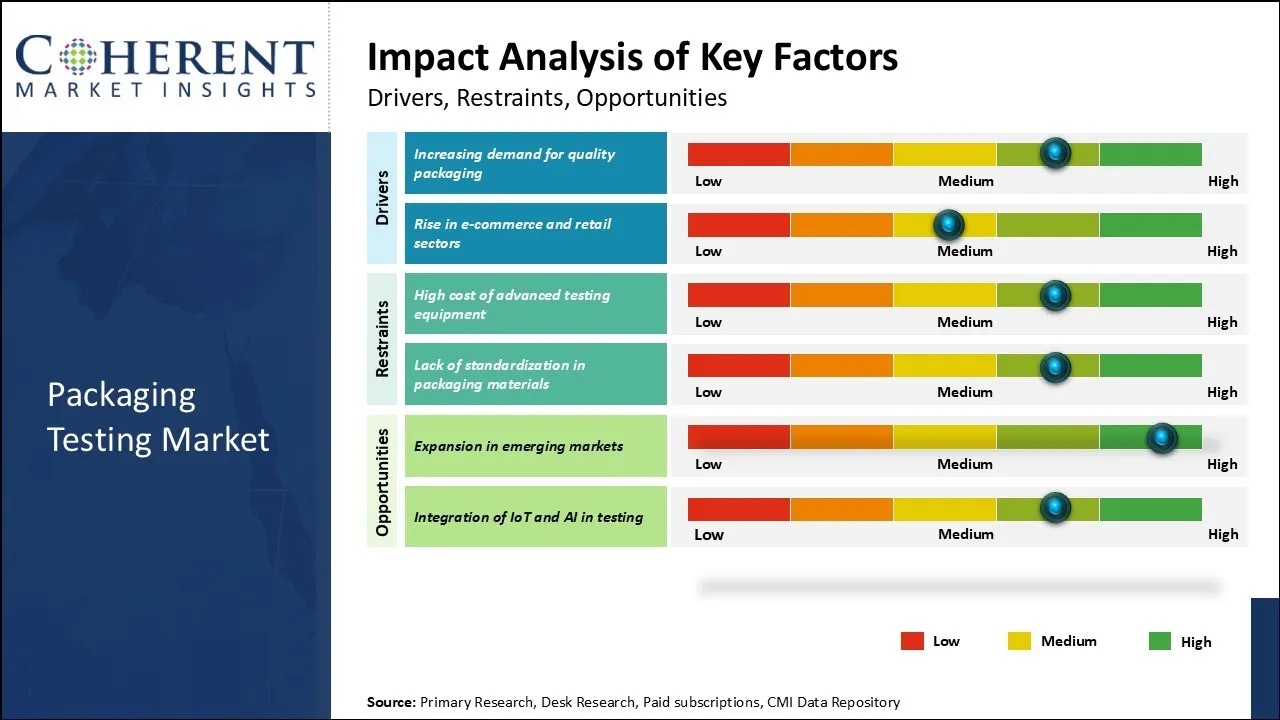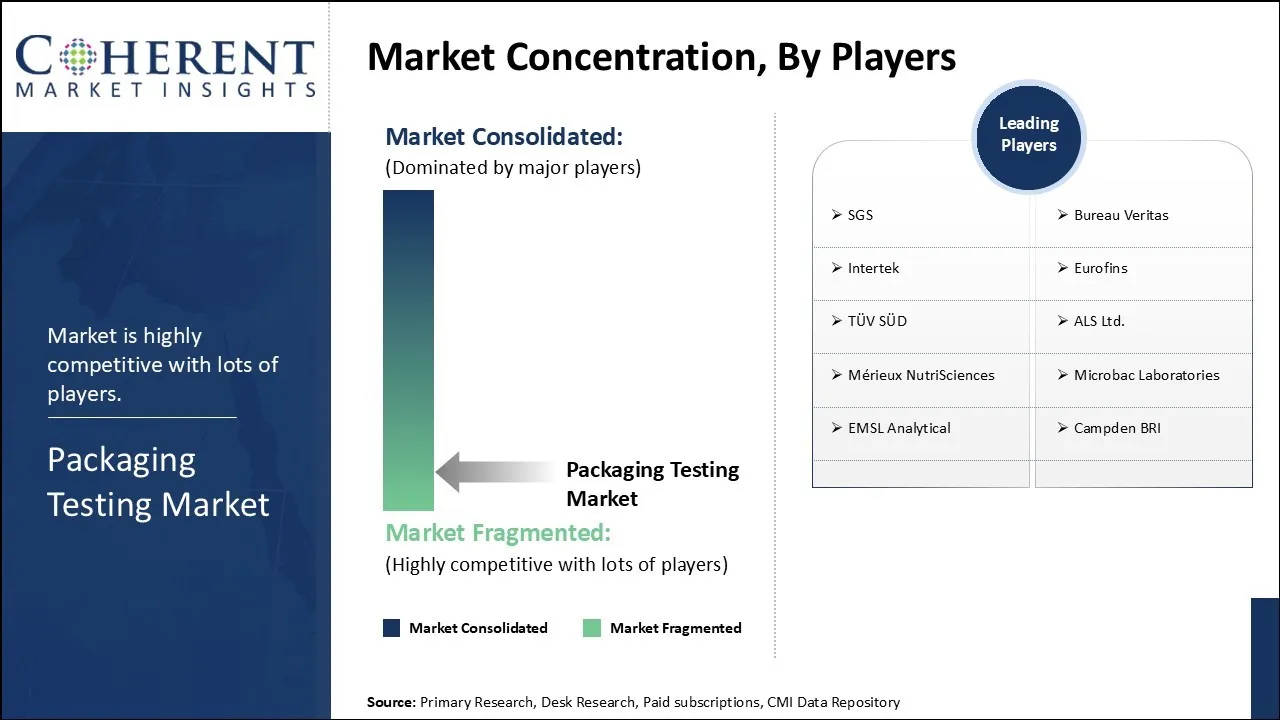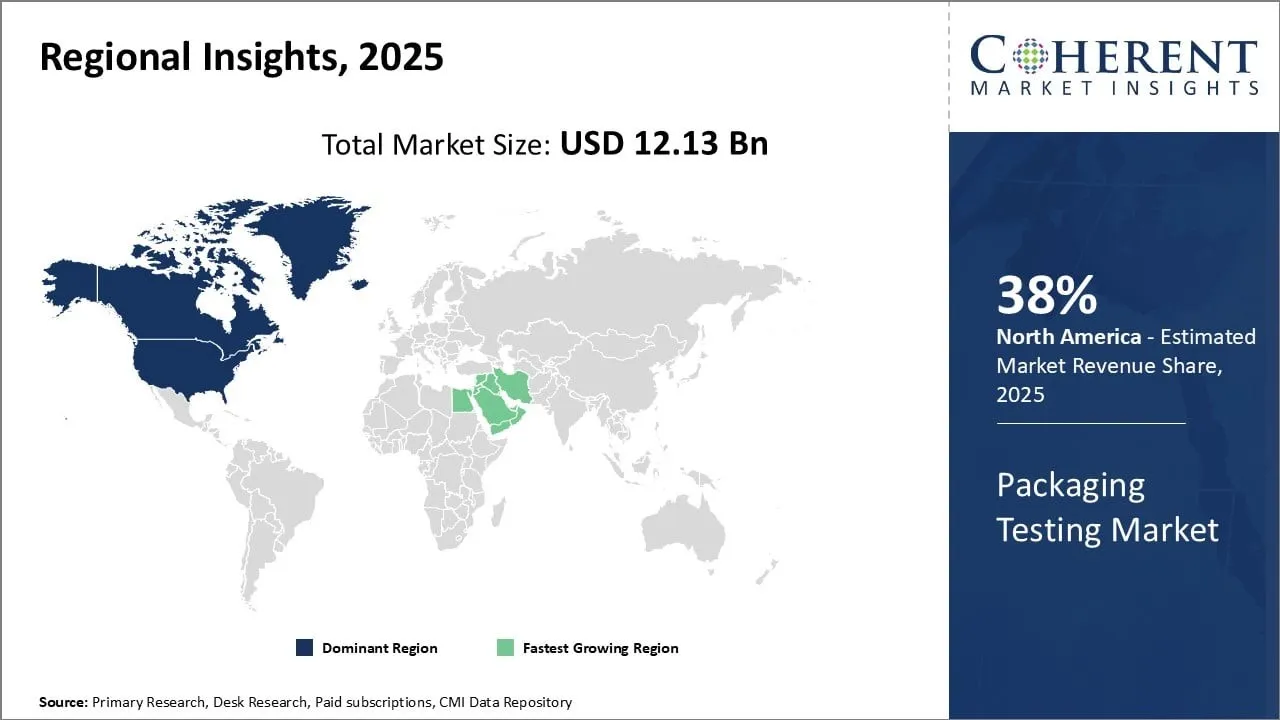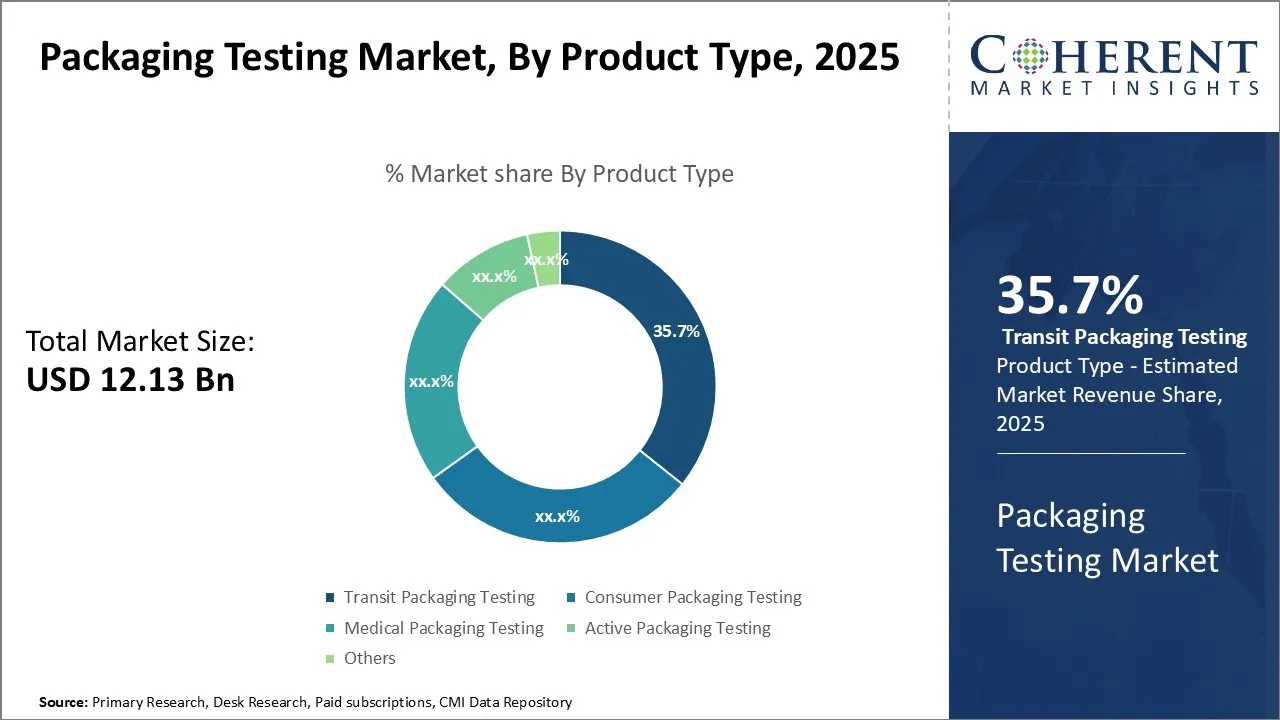Packaging Testing Market Size and Trends Forecast: 2025 - 2032
The Packaging Testing Market size is expected to reach USD 20.51 Bn by 2032, from USD 12.13 Bn in 2025, exhibiting a CAGR of 7.8% during the forecast period.
Key Takeaways of the Packaging Testing Market
- Based on product type, the transit packaging testing segment is projected to dominate, holding a share of 35.7% in 2025.
- North America is expected to dominate the packaging testing market with 38% of the market share in 2025.
- Middle East & Africa is expected to be the fastest-growing market for packaging testing, exhibiting a CAGR of over 9.5% during the forecast period.
- Asia Pacific is expected to be the second-largest market for packaging testing, accounting for over 25% of the market share in 2025.
Market Overview

To learn more about this report, Download Free Sample
The packaging testing market is expected to grow steadily over the next five years primarily due to stringent government regulations regarding product safety and quality. Growing consumer awareness about potential contamination and toxins is also driving more companies to thoroughly test their packaging materials.
However, high capital investment requirements is one of the factors responsible for the growth of the packaging testing market.
Market Concentration and Competitive Landscape

To learn more about this report, Download Free Sample
Current Events and Their Impact on the Packaging Testing Market
|
Current Events |
Description and its impact |
|
Regulatory & Environmental Policies Shaping Packaging Standards |
|
|
Supply Chain Disruptions and Economic Volatility |
|
Uncover macros and micros vetted on 75+ parameters: Get instant access to report
Growing Focus on Sustainability and Environmental Impact
The increasing global emphasis on sustainability and environmental stewardship has significantly influenced the packaging testing market, acting as a critical growth driver. Governments, regulatory bodies, and non-profit organizations globally are advocating for the reduction of plastic waste, carbon footprints, and the overall environmental impact of packaging materials. This growing focus compels manufacturers and brands to rigorously test packaging solutions to ensure they meet eco-friendly standards, use recyclable or biodegradable materials, and maintain product safety during transportation.
For instance, according to Shorr’s 2025 sustainable packaging consumer report that surveyed 2,016 American consumers, the findings are striking. Over half (54%) of respondents reported deliberately choosing products with sustainable packaging in the past six months. Even more compelling, 90% said they are more likely to purchase from a brand or retailer if its packaging is eco-friendly.
Packaging Testing Market Insights, By Product Type: Transit Packaging Testing Contributes the Highest Share in the Market, Owing to Its Critical Role in Ensuring the Safety and Integrity of Goods
In terms of product type, the transit packaging testing segment is expected to contribute 35.7% share of the market in 2025, owing to the continuous innovation within sectors like electronics, automotive components, and food and beverage, where safe delivery without damage can have considerable economic consequences.
The global logistics ecosystem has seen remarkable complexity and expansion, driven by the surge in e-commerce, globalization of manufacturing, and diversified transportation modes, including road, rail, air, and sea freight. Transit packaging must withstand shocks, vibrations, compression forces, and environmental stressors encountered in this journey, making its testing indispensable.
Emerging Innovations in the Packaging Testing Market
- The Integration of Internet of Things (IoT) and Smart Sensors
- These connected devices provide real-time monitoring and data collection capabilities that allow manufacturers to track parameters such as temperature, humidity, pressure, and mechanical stress throughout the supply chain. This integration enables predictive analytics to foresee potential failures or degradation in packaging, leading to proactive measures rather than reactive quality control.
- The Shift Toward Digitalization and Automation
- Traditional manual testing has been gradually replaced or supplemented by automated systems that use robotics, sensors, and advanced imaging techniques. Automation not only accelerates the testing process but also reduces human error and improves repeatability. This is crucial in industries like pharmaceuticals, where packaging integrity directly impacts product safety, shelf life, and regulatory compliance.
Impacts of Artificial Intelligence (AI) in the Packaging Testing Market
The integration of AI within this niche is creating new opportunities for innovation, efficiency, and value across the entire packaging lifecycle.
- Berry global is a leading manufacturer of plastic packaging products. Berry Global has integrated AI-powered inspection systems into its production lines to detect defects such as leaks, seal integrity failures, and material inconsistencies in real time. By leveraging machine learning algorithms, the company enhances defect identification accuracy and reduces human error, allowing quicker corrective actions. This shift to AI-enabled inspection not only improves production efficiency but also ensures higher compliance with regulatory standards and customer expectations.
- Amcor, a global packaging provider, has implemented AI-based image recognition and sensor data analytics to assess the structural integrity of packaging materials under various stress conditions. By using AI models trained on extensive test data, Amcor can predict potential failure points before physical testing, significantly reducing testing time and costs.
Regional Insights

To learn more about this report, Download Free Sample
North America Packaging Testing Market Analysis and Trends
North America is expected to be the largest market for packaging testing during the forecast period, accounting for over 38% of the market share in 2025. The U.S. Food and Drug Administration (FDA) along with the U.S. Department of Agriculture (USDA) and the Environmental Protection Agency (EPA) enforce stringent packaging standards that mandate rigorous testing protocols, ensuring packaging materials meet safety, durability, and environmental compliance requirements.
For instance, in February 2025, TIPA—a global leader in compostable packaging innovation—launched an advanced home‑compostable, metallized high‑barrier film in the U.S. The new solution addressed key eco‑packaging challenges for chips and salty snacks by combining enhanced barrier performance against salt, oil, and moisture with durability in a fully biodegradable material
Middle East & Africa Packaging Testing Market Analysis and Trends
Middle East & Africa is expected to be the fastest-growing market for packaging testing, exhibiting a CAGR of over 9.5% during the forecast period. The market growth in the Middle East & Africa is attributed to the rising demand for packaged food and beverages due to changing lifestyles and growing retail sector in the region.
Packaging Testing Market Outlook for Key Countries
U.S. Packaging Testing Market Analysis and Trends
The U.S. remains a dominant force in the packaging testing market, largely driven by a combination of strict regulatory frameworks and environmentally conscious consumer behavior. Agencies such as the U.S. Food and Drug Administration (FDA), Environmental Protection Agency (EPA), and American Society for Testing and Materials (ASTM) International mandate rigorous packaging standards for food safety, pharmaceuticals, and hazardous materials. In addition, a growing number of American consumers are choosing products based on sustainable and recyclable packaging, which compels brands to conduct thorough testing to validate performance, shelf life, and eco-friendliness before product launch.
Germany Packaging Testing Market Analysis and Trends
Germany leads the Europe packaging testing market due to its strong emphasis on engineering precision, automation, and innovation in packaging technology. As a hub for packaging machinery manufacturing and material science R&D, Germany also adheres strictly to EU directives on plastic reduction, recyclability, and carbon emissions, such as the Packaging and Packaging Waste Regulation (PPWR). These regulations require manufacturers to perform extensive testing on materials to ensure compliance with recyclability and environmental impact criteria, driving demand for sophisticated packaging testing solutions.
China Packaging Testing Market Analysis and Trends
China is rapidly expanding its role in the global packaging testing market, driven by explosive growth in e-commerce, food exports, and pharmaceutical manufacturing. With rising exports to North America and Europe, Chinese manufacturers must meet international packaging standards, prompting increased investment in testing equipment and services. In addition, domestic regulations under China's Green Packaging Standards are pushing industries toward environmentally safe and durable packaging, reinforcing the need for rigorous performance and sustainability testing.
India Packaging Testing Market Analysis and Trends
India’s packaging testing market is fueled by the expanding fast-moving consumer goods (FMCG) sector, along with a rising emphasis on sustainable packaging through government initiatives like the Plastic Waste Management Rules and Extended Producer Responsibility (EPR). With a diverse consumer base and increasing demand for packaged food, personal care, and pharmaceuticals, packaging integrity and safety are becoming critical. As a result, manufacturers are turning to advanced packaging testing to meet both domestic safety standards and global export requirements.
Pricing Analysis of the Packaging Testing Market
|
Software Type |
Price Range |
|
Data Management & Analysis, Instron Bluehill, Zwick TestXpert |
USD 3,000 – USD 30,000 annually |
|
Cloud-Based Monitoring Suites, Bureau Veritas, UL Solutions |
USD 1,000 – USD 10,000 annually |
Uncover macros and micros vetted on 75+ parameters: Get instant access to report
Macro & Micro- Economic Factors Impacting the Growth of the Packaging Testing Market
|
Macro-Economic Factors |
Micro-Economic Factors |
|
Regulatory Compliance Pressures: Stringent global regulations drive mandatory testing across sectors. For instance, the EU’s Packaging and Packaging Waste Regulation mandates environmental compliance, forcing companies to validate materials’ recyclability and chemical safety. This requirement has spurred demand for specialized testing services. For example, pharmaceutical companies must comply with the U.S. Food and Drug Administration (FDA) regulations for tamper-evident packaging, necessitating rigorous integrity and sterility testing, particularly after COVID-19 accelerated pharma production. |
Competitive Pressure and Innovation: Firms like Intertek, SGS, and Eurofins invest in automation and expanded lab networks to differentiate offerings. Example: Intertek’s digital testing platforms enable faster, cost-efficient evaluations, reducing client wait times. |
|
Globalization and E-Commerce Expansion: E-commerce’s USD 6.3 trillion revenue in 2024 has intensified transit testing. For example, Amazon’s global logistics network requires drop tests and vibration simulations to ensure packaging withstands transcontinental shipping. This trend is evident in the transit packaging testing segment, which holds the largest market share due to logistics sector demand. |
Cost Optimization and Pricing Strategies: Companies balance quality and affordability through automation. Example: Mid-sized manufacturers adopt AI-powered predictive testing to reduce rework costs, targeting mid-market segments. This aligns with the market’s shift toward scalable, economical solutions. |
Uncover macros and micros vetted on 75+ parameters: Get instant access to report
Market Report Scope
Packaging Testing Market Report Coverage
| Report Coverage | Details | ||
|---|---|---|---|
| Base Year: | 2024 | Market Size in 2025: | USD 12.13 Bn |
| Historical Data for: | 2020 To 2024 | Forecast Period: | 2025 To 2032 |
| Forecast Period 2025 to 2032 CAGR: | 7.8% | 2032 Value Projection: | USD 20.51 Bn |
| Geographies covered: |
|
||
| Segments covered: |
|
||
| Companies covered: |
Intertek Group plc, SGS SA, Bureau Veritas, Eurofins Scientific, TÜV SÜD AG, Mérieux NutriSciences, Microbac Laboratories, Inc., ALS Limited, National Technical Systems, Inc. (NTS), and Westpak, Inc. |
||
| Growth Drivers: |
|
||
| Restraints & Challenges: |
|
||
Uncover macros and micros vetted on 75+ parameters: Get instant access to report
Packaging Testing Industry News
- In July 2025, Mérieux NutriSciences, a global leader in food safety, quality, and sustainability, announced the successful completion of its acquisition of Bureau Veritas’ food testing activities in Ecuador.
- In March 2025, SGS SA announced the opening of a new dedicated furniture and transit packaging testing laboratory in Central Java, Indonesia. It offers fast turnaround times, helping clients accelerate their access to target markets while ensuring compliance and enhancing product quality.
- In March 2025, TÜV SÜD expanded its laboratory in Frankfurt am Main—located at Daimlerstraße 40—to bolster its testing capabilities in areas such as product innovation, quality, and safety. The upgraded facilities were officially unveiled at an “Open Lab Day”, where customers and employees received exclusive tours of the state-of-the-art testing environments.
- In January 2025, Eurofins Medical Device Testing opened a new state-of-the-art package testing facility to strengthen its end-to-end testing services for the medical device industry, including functionality, material integrity, sterile seal, transit resilience, and aging studies.
Analyst View
- The packaging testing market is witnessing robust momentum driven by increasing consumer demand for product safety, quality assurance, and regulatory compliance across various industries such as food and beverages, pharmaceuticals, and electronics. Growing complexity in packaging designs and a surge in automation and smart packaging solutions further propel the need for advanced packaging testing methods.
- However, challenges such as high testing costs and lack of standardized testing protocols in emerging economies could restrain market expansion to some extent.
- Opportunities abound with rising awareness about sustainable packaging and the need to validate biodegradable and recyclable materials. Innovations in testing technologies, including non-destructive testing and AI-enabled inspection systems, offer significant prospects for enhancing efficiency and accuracy in packaging evaluation. The growing popularity of e-commerce, which demands robust packaging to protect goods during transit, also fuels the demand for comprehensive packaging testing.
- Regionally, North America continues to dominate due to stringent regulatory frameworks and strong presence of key players investing in R&D activities.
- Overall, the packaging testing market is poised for dynamic transformation, driven by technological advancements and an increasing emphasis on sustainability and safety standards globally.
Market Segmentation
- Product Type Insights (Revenue, USD Bn, 2020-2032)
- Transit Packaging Testing
- Consumer Packaging Testing
- Medical Packaging Testing
- Active Packaging Testing
- Others
- Material Insights (Revenue, USD Bn, 2020-2032)
- Plastic
- Glass
- Metal
- Paper & Board
- Others
- Technology Insights (Revenue, USD Bn, 2020-2032)
- Physical Testing
- Chemical Testing
- Microbiological Testing
- Others
- End-use Industry Insights (Revenue, USD Bn, 2020-2032)
- Food & Beverage
- Healthcare
- Consumer Electronics
- Automotive
- Logistics
- Others
- Regional Insights (Revenue, USD Bn, 2020-2032)
- North America
- U.S.
- Canada
- Latin America
- Brazil
- Argentina
- Mexico
- Rest of Latin America
- Europe
- Germany
- U.K.
- Spain
- France
- Italy
- Russia
- Rest of Europe
- Asia Pacific
- China
- India
- Japan
- Australia
- South Korea
- ASEAN
- Rest of Asia Pacific
- Middle East & Africa
- GCC Countries
- Israel
- South Africa
- Rest of Middle East & Africa
- Key Players Insights
- SGS
- Bureau Veritas
- Intertek
- Eurofins
- TÜV SÜD
- ALS Ltd.
- Mérieux NutriSciences
- Microbac Laboratories
- EMSL Analytical
- Campden BRI
Sources
Primary Research Interviews
- Packaging Material Manufacturers
- Quality Control Managers in FMCG Companies
- Testing Equipment Suppliers
- Industry Experts & Analysts
- Others
Magazines
- Packaging World
- Packaging Europe
- Global Packaging Magazine
- Packaging Digest
- Others
Journals
- Journal of Packaging Technology and Research
- Packaging Technology and Science
- Journal of Applied Packaging Research
- Packaging Technology and Engineering
- Others
Newspapers
- The Wall Street Journal (Industry Section)
- Financial Times (Manufacturing Sector)
- The Economic Times (Consumer Goods & Packaging)
- The Business Standard
- Others
Associations
- International Safe Transit Association (ISTA)
- Institute of Packaging Professionals (IoPP)
- Flexible Packaging Association (FPA)
- Packaging Industry Association of Canada (PIAC)
- Others
Public Domain Sources
- U.S. Food and Drug Administration (FDA) Reports
- European Packaging Institute Publications
- World Packaging Organization Reports
- Market Regulatory Authority Websites
- Others
Proprietary Elements
- CMI Data Analytics Tool – Packaging Testing Market
- CMI Existing Repository of Information for the Last 8 Years
*Definition: Packaging testing involves evaluating packaging materials and packaging components to ensure they are fit for the intended use and comply with regulations. It determines the durability, strength, shelf-life safety, and quality of packaging across industries such as food, beverages, pharmaceuticals, cosmetics, consumer goods, etc. Key tests include physical, chemical, and microbiological testing. Packaging testing ensures safety, quality, and integrity of packaged products. It is conducted by third-party testing laboratories and packaging manufacturers using standard test methods and equipment. The growing demand for packaged goods globally, rising focus on consumer safety, and stringent regulations are driving the packaging testing market growth.
Share
Share
About Author
Kalpesh Gharte is a senior consultant with approximately 5 years of experience in the consulting industry. Kalpesh holds an MBA in Operations and Marketing Management, providing him with a strong foundation in market strategy and analysis. He has contributed to various consulting and syndicated reports, delivering valuable insights that support informed business decisions
Missing comfort of reading report in your local language? Find your preferred language :
Transform your Strategy with Exclusive Trending Reports :
Frequently Asked Questions
EXISTING CLIENTELE
Joining thousands of companies around the world committed to making the Excellent Business Solutions.
View All Our Clients

